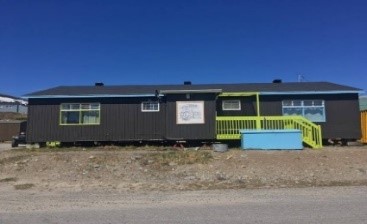Creating Supportive Housing
Creating Supportive Housing:
Providing services and supports at home
Product of the Northern Housing Forum
Yellowknife, NT, May 2018
 SUPPORTIVE HOUSING |
Supportive housing models bring services and supports directly to individuals. They help people who have difficulty living independently or remaining in their housing.1 Supportive housing addresses the root causes and re-occurring pathways to housing insecurity and may include a mix of different units, programs, and clientele. It reduces the cycles of institutionalization and homelessness among people who need assistance to maintain independent housing.2 The causes of homelessness are varied and often complex3, therefore supportive housing approaches must be just as unique.
 RECOMMENDATIONS |
- Conduct a supportive housing needs assessment to determine the demand for units, services and programs, as well as individuals who require support services.4 Housing needs will differ between communities and over time as demographics change.
- – Support services can include assistance with life skills, counseling, crisis intervention, home maintenance, and opportunities for peer support and community involvement.
- Mobilize partnerships among service providers to coordinate resources and provide multi-disciplinary support teams to support holistic care.
- Build on local capacity and resources to deliver supportive housing services, including cultural and social programming and physical resources.
- – Partner with northern colleges to identify training gaps and opportunities.
- Involve service providers who have ‘lived’ experience and share cultural values.
- Explore holistic housing approaches for rural and remote communities5, including the Housing First model in which support systems help with transitions and remain supportive as long as required.5
- – Establish the evaluation process at the beginning of each program with the community.
 CONDITIONS FOR SUCCESS |
- Understand vulnerable populations: A one-size-fits-all approach does not reflect the needs of vulnerable individuals. It is important to understand context (i.e. why people are experiencing homelessness, what level and type of support is required), and to take time to match individual needs with available supportive housing units. Up-to-date and person-specific data is required for success.6
- Partner and collaborate: Partnerships between different levels of government, housing authorities, and social service providers help ensure the necessary resources are available at the right time, in the right manor.
- Learn from others: Knowledge exchange between regional governments and housing authorities enables integration of best practices. Share experiences, lessons learned and best practices with your colleagues to build for success.
- Develop a clear vision: Successful housing-first initiatives require a “clear vision, community consultation, support and education, and strong support networks for smooth transitions.”7
 SUCCESS STORIES |
The City of Yellowknife funds the Yellowknife Women’s Society to operate a housing-first program in which case workers and a peer support worker help people with complex needs find housing and access “wrap-around” support services for their recovery and stability.8
Qarmaapik House, located in Kangiqsualujjuaq, Nunavik, is a community-driven and culturally appropriate safe house that supports youth and families in crisis. Qarmaapik provides services and programming that seek to address underlying causes of family conflict and breakdown. It provides temporary lodging for families and acts as a drop-in centre.9
Housing First is a “recovery-oriented approach to homelessness that involves moving people who experience homelessness into independent and permanent housing as soon as possible, with no preconditions, and then providing them with additional supports and services as needed.”10 This approach has been shown to improve mental health, safety, security, and social connectedness.11
To support housing-first programming development in the territory, the Government of Yukon worked with the Canadian Alliance to End Homelessness to offer a Housing First 101 training session for service providers, housing stakeholders and interested members of the public.12
__________________________
- The Social Housing Registry of Ottawa. 2014. URL: http://www.housingregistry.ca/supportive-housing/
- Ibid
- Walsh. D. 2018. Why research matters: Methodology as best practice in understanding hidden homelessness. 2018 Northern Housing Forum, Yellowknife.
- Nunavut Housing Corporation. 2016. The Blueprint for Action on Housing. URL: https://s3.amazonaws.com/nhcweb/publications/blueprint_0.pdf
- Christensen, J. 2018. Northern Homelessness, Northern Solutions: Housing First and Cultural Safety. 2018 Northern Housing Forum, Yellowknife.
- J. Christenson, Pathways to homelesness: Rural-urban migration & housing Insecurity in Yellowknife and Inuvik, Northwest Territories, Inuvik, 2011
- Young and Manion, "Harm reduction through housing first: an assessment of the Emergency Warming Centre in Inuvik, Canada," Harm Reduction Journal, vol. 14, no. 8, pp. 1-11, 2017.
- Turner Strategies. 2017. Everyone is Home: Yellowknife’s 10 Year Plan to End Homelessness.
- Emudluk, M. 2017. Qarmaapik House: A multi-use and safe place for families in Kangiqsualujjuaq. Northern Public Affairs, July 2017; p37-40.
- Gaetz, S., Scott, F. and Gulliver, T. (Eds.) 2013. Housing First in Canada: Supporting Communities to End Homelessness. Toronto: Canadian Homelessness Research Network Press. p. 2
- Christensen, J. 2018. Northern Homelessness, Northern Solutions: Housing First and Cultural Safety. 2018 Northern Housing Forum, Yellowknife.
- Yukon Government, "Ours to Build On: Housing Action Plan for Yukon," Yukon Government, Whitehorse, 2018.

